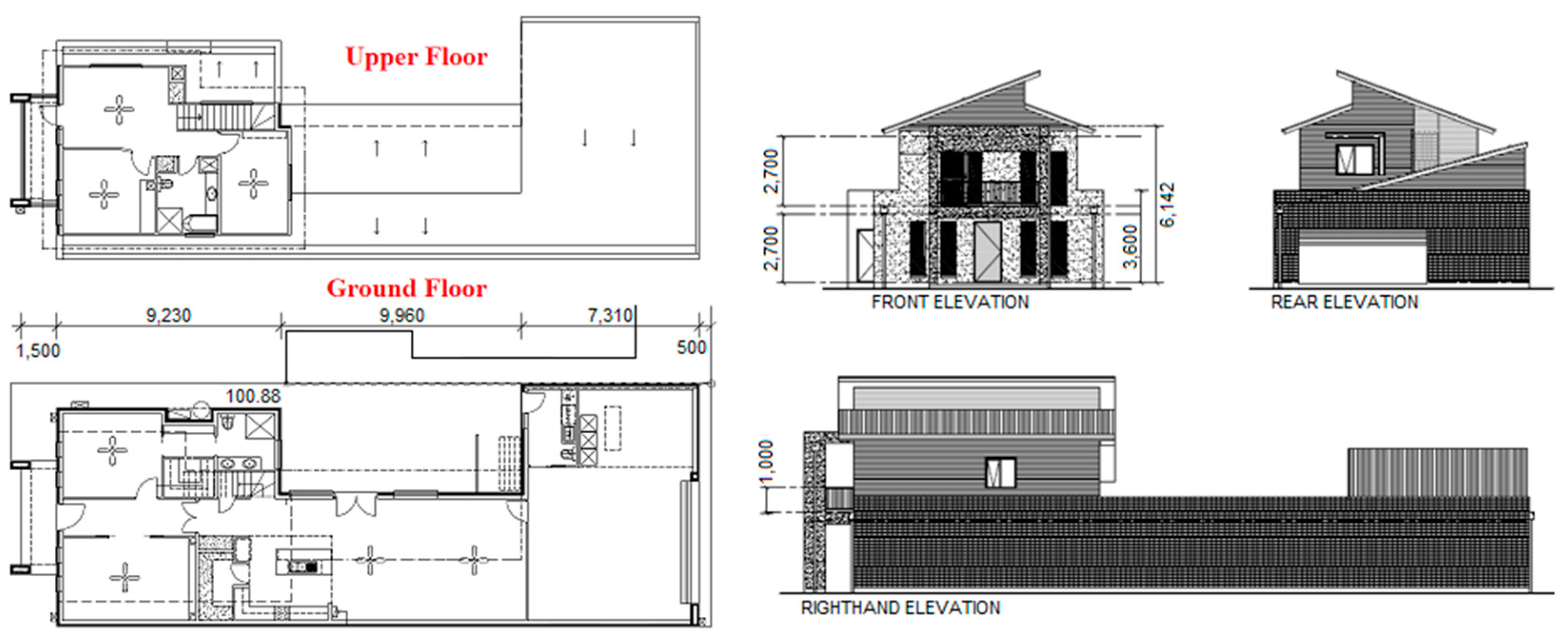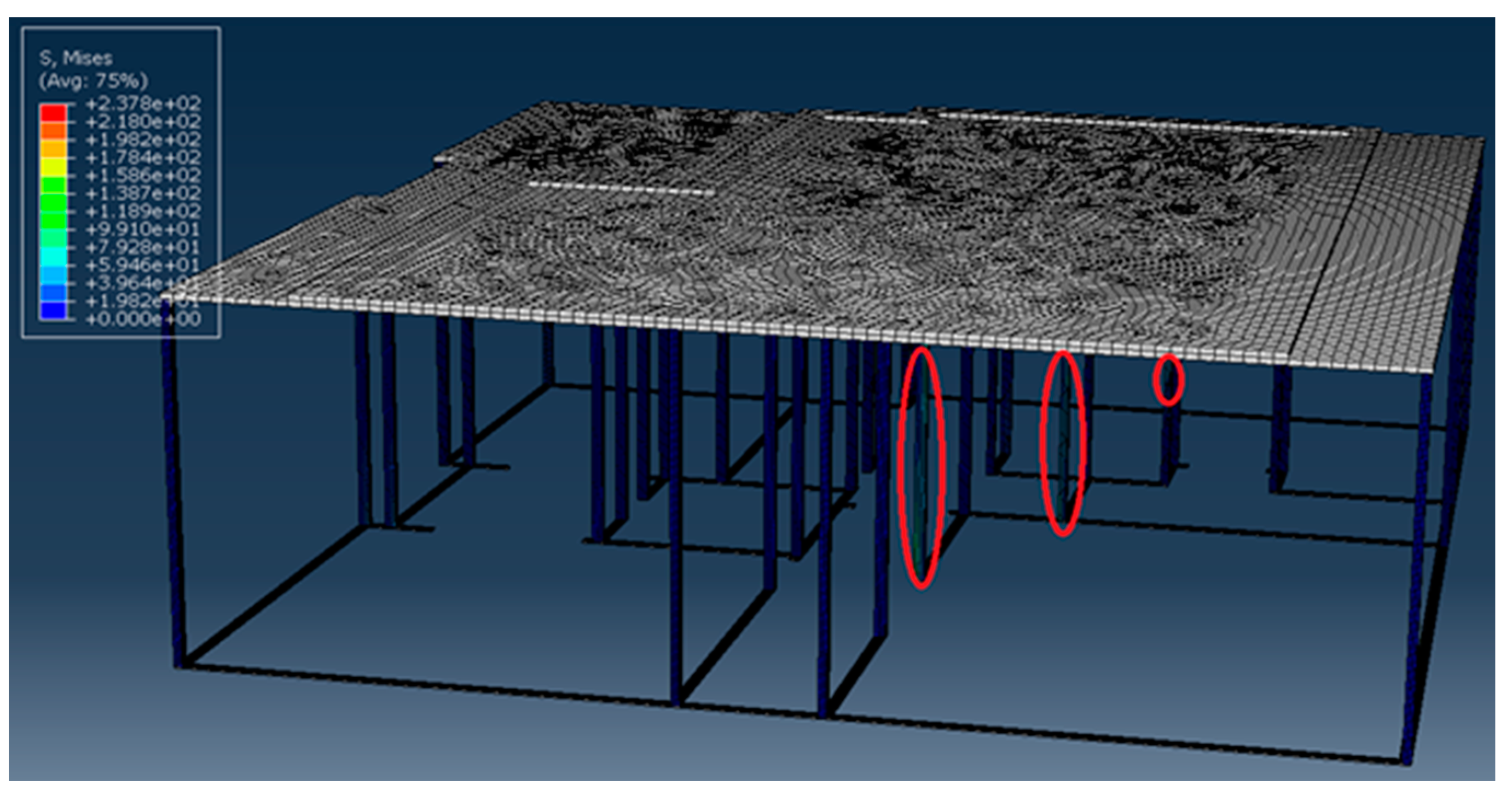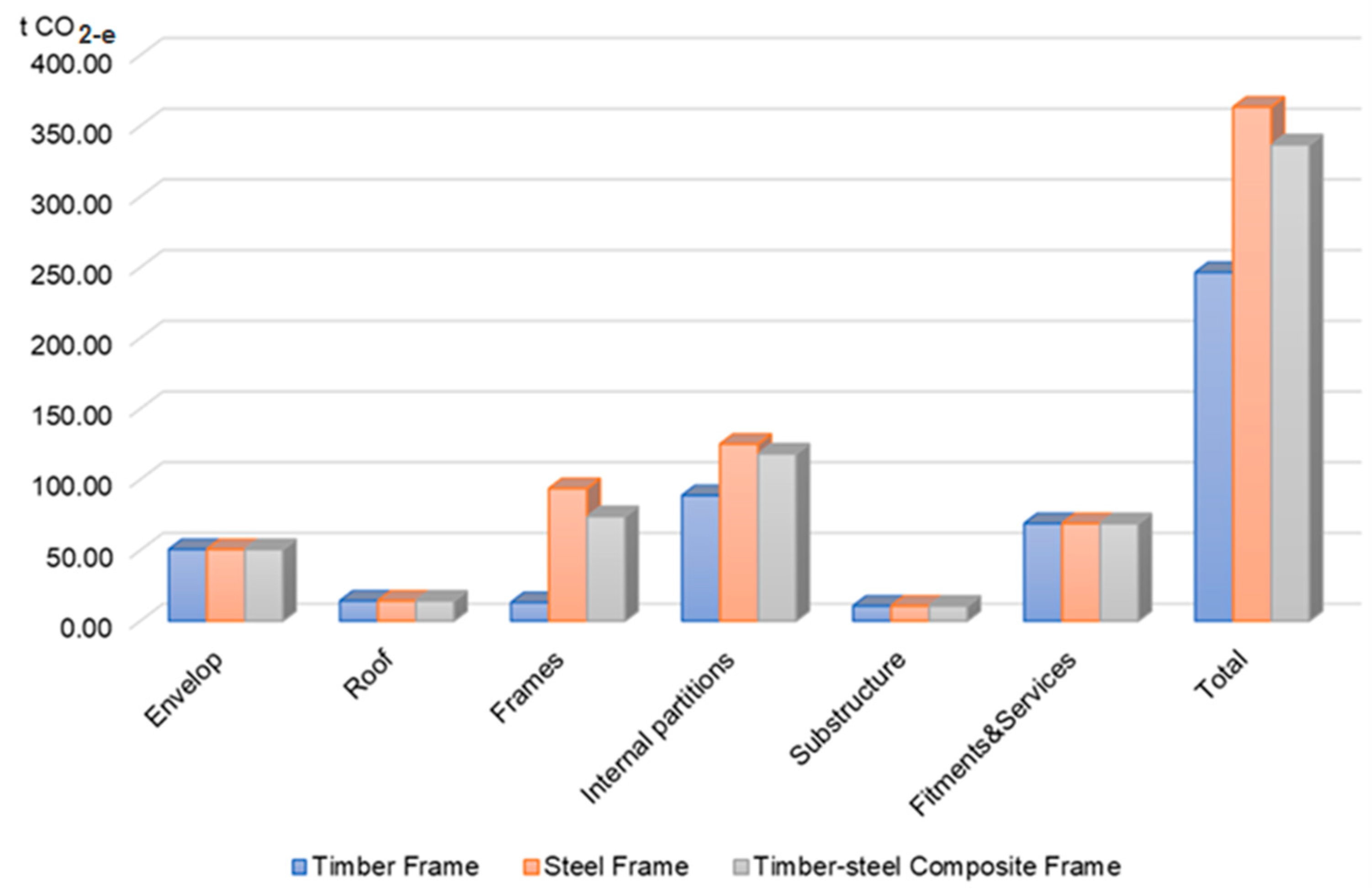Exploring Embodied Carbon Comparison in Lightweight Building Structure Frames: A Case Study
Abstract
:1. Introduction
2. Materials and Methods
2.1. Building Archetype and Structural Information
- (a)
- To explore, evaluate, and compare the impact of embodied carbon changes contributed by different building frames, only the building frame materials (namely steel, timber, and steel-timber composite) are different in the three currently considered scenarios, while the other building enclosure/envelope structures remain unchanged.
- (b)
- The dimensions of various components of the building frame are determined using Finite Element Analysis (FEA), to ensure that the entire building frame has sufficient structural strength. A safety factor of 2.0 was set for the FEA simulations (the recommended safety factor in the local building code ranged between 1.5 and 2.5).
- (c)
- The loading on the ground-floor frame was considered to be the entire weight of the upper floor, including the enclosure, floor, furniture, and appliances.
- (d)
- A 10% amplitude has been applied in the dynamic explicit FEA simulations to ensure that the structures are of sufficient dynamic stabilities.
- (e)
- The change in the building frame has a limited impact on its thermal performance and thus would not significantly affect the operational carbon of buildings.
2.2. Modelling and Assessment Methods
3. Results
3.1. Building Modelling
3.2. Frame Design and FEA Simulations
3.3. Embodied Carbon and Cost Assessments
4. Discussion
5. Conclusions
Author Contributions
Funding
Institutional Review Board Statement
Informed Consent Statement
Data Availability Statement
Acknowledgments
Conflicts of Interest
Appendix A
| Building Elements | Unit | Density (kg/Unit) | Carbon Intensity (kg CO2-e/Unit) |
|---|---|---|---|
| Plaster (cement: sand 1:4) | per m2 wall | 22.50 | 6.75 |
| Plasterboard (10 mm thickness) | per m2 | 10.00 | 7.50 |
| Plasterboard (20 mm thickness) | per m2 | 20.00 | 15.00 |
| Brickwork | per m2 envelop | 197.63 | 167.99 |
| Rockwool batt R2.0 | per m2 floor | 1.25 | 0.75 |
| Rockwool batt R2.5 | per m2 wall | 1.95 | 1.17 |
| Rockwool batt R4.0 | per m2 ceiling | 5.28 | 3.17 |
| Mortar | per m2 wall | 13.00 | 3.25 |
| Timber frame | per m2 wall | 12.76 | 3.19 |
| Steel frame | per m2 wall | 40.00 | 60.00 |
| Steel-reinforced wall panel | per m2 wall | 50.00 | 42.50 |
| Colourbond roof-steel | per m2 roof | 4.90 | 9.90 |
| Roof truss-timber | per m2 roof | 16.5 | 4.13 |
| Roof truss-steel | per m2 roof | 20.00 | 30.00 |
| Guttering | per meter | 1.26 | 14.40 |
| Glass-window | per m2 | 10.00 | 5.00 |
| Window frame-timber | per m2 | 16.30 | 0.59 |
| Window frame-aluminium | per m2 | 6.00 | 13.26 |
| External door-timber | per m2 | 32.50 | 10.00 |
| Internal door-timber | per m2 | 12.64 | 6.49 |
| Stairs-timber | per storey | 350.00 | 250.00 |
| Floor-carpet 10 + felt underlay 10 | per m2 floor area | 2.25 | 28 |
| Floor-timber truss | per m2 floor area | 25.52 | 6.38 |
| Floor-steel truss | per m2 floor area | 12.76 | 25.52 |
| Drains | per m2 floor area | 0.30 | 9.95 |
| Ceramic tile | per m2 | 17.00 | 30.00 |
| Concrete: standard | per m2 floor area | 240.00 | 30.00 |
| * Cabinets | per m2 floor area | 89.2 | 224.78 |
| * Oven/hob | per each | 50.00 | 80.00 |
| * Air-conditioner | per each | 58.00 | 450.00 |
| * Dish washer | per each | 70.00 | 400.00 |
| * Fridge | per each | 300.00 | 200.00 |
| * Wash machine | per each | 80.00 | 350.00 |
| Piping | per m2 floor area | 1.31 | 40.43 |
| Steel sinks | per each | 6.00 | 104.94 |
| * WCs | per each | 12.00 | 12.24 |
| Handbasins | per each | 13.00 | 13.26 |
| Taps/fittings | per each | 3.60 | 16.92 |
| * Baths | per each | 6.80 | 35.77 |
| Water Service | per each | 70.00 | 1852.90 |
| Wire | per storey | 23.50 | 260.15 |
| Fittings | per room | 0.10 | 5.26 |
| C-channel steel structure | per linear meter | 57.68 | 86.52 |
| * Bed | per each | 160.00 | 270.00 |
| * Desk | per each | 40.00 | 80.00 |
| * Sofa | per each | 60.00 | 190.00 |
| Pavers-concrete | per m2 floor area | 80.60 | 20.15 |
| Pergola-timber | per m2 floor area | 10.70 | 6.31 |
| Fences-timber | per linear meter | 8.40 | 4.96 |
| * Garage door | per m2 | 6.50 | 45.00 |
| Shed-steel | per m2 floor area | 3.60 | 43.92 |
| Steel RHS pole | per linear meter | 16.30 | 25.26 |
References
- Ching, E.; Carstensen, J.V. Truss topology optimization of timber–steel structures for reduced embodied carbon design. Eng. Struct. 2022, 252, 113540. [Google Scholar] [CrossRef]
- Zhang, Y.; Teoh, B.K.; Wu, M.; Chen, J.; Zhang, L. Data-driven estimation of building energy consumption and GHG emissions using explainable artificial intelligence. Energy 2023, 262, 125468. [Google Scholar] [CrossRef]
- Ahmed Ali, K.; Ahmad, M.I.; Yusup, Y. Issues, Impacts, and Mitigations of Carbon Dioxide Emissions in the Building Sector. Sustainability 2020, 12, 7427. [Google Scholar] [CrossRef]
- Huang, B.; Xing, K.; Ness, D.; Liao, L.L.; Huang, K.; Xie, P.L.; Huang, J.L. Rethinking carbon–neutral built environment: Urban dynamics and scenario analysis. Energy Build. 2022, 255, 111672. [Google Scholar] [CrossRef]
- Pomponi, F.; Moncaster, A. Embodied carbon mitigation and reduction in the built environment—What does the evidence say? J. Environ. Manag. 2016, 181, 687–700. [Google Scholar] [CrossRef] [PubMed]
- Chan, M.; Masrom, M.A.N.; Yasin, S.S. Selection of Low-Carbon Building Materials in Construction Projects: Construction Professionals’ Perspectives. Buildings 2022, 12, 486. [Google Scholar] [CrossRef]
- Salama, A.; Atif Farag, A.; Eraky, A.; El-Sisi, A.A.; Samir, R. Embodied Carbon Minimization for Single-Story Steel Gable Frames. Buildings 2023, 13, 739. [Google Scholar] [CrossRef]
- Hunt, J.; Osorio-Sandoval, C.A. Assessing Embodied Carbon in Structural Models: A Building Information Modelling-Based Approach. Buildings 2023, 13, 1679. [Google Scholar] [CrossRef]
- Hawkins, W.; Cooper, S.; Allen, S.; Roynon, J.; Ibell, T. Embodied carbon assessment using a dynamic climate model: Case-study comparison of a concrete, steel and timber building structure. Structures 2021, 33, 90–98. [Google Scholar] [CrossRef]
- Robati, M.; Oldfield, P. The embodied carbon of mass timber and concrete buildings in Australia: An uncertainty analysis. Build. Environ. 2022, 214, 108944. [Google Scholar] [CrossRef]
- Hafner, A.; Schäfer, S. Comparative LCA study of different timber and mineral buildings and calculation method for substitution factors on building level. J. Clean. Prod. 2018, 167, 630–642. [Google Scholar] [CrossRef]
- Morris, F.; Allen, S.; Hawkins, W. On the embodied carbon of structural timber versus steel, and the influence of LCA methodology. Build. Environ. 2021, 206, 108285. [Google Scholar] [CrossRef]
- Zeitz, A.; Griffin, C.T.; Dusicka, P. Comparing the embodied carbon and energy of a mass timber structure system to typical steel and concrete alternatives for parking garages. Energy Build. 2019, 199, 126–133. [Google Scholar] [CrossRef]
- Chen, Z.; Gu, H.; Bergman, R.D.; Liang, S. Comparative life-cycle assessment of a high-rise mass timber building with an equivalent reinforced concrete alternative using the Athena impact estimator for buildings. Sustainability 2020, 12, 4708. [Google Scholar] [CrossRef]
- De Wolf, C.; Hoxha, E.; Hollberg, A.; Fivet, C.; Ochsendorf, J. Database of embodied quantity outputs: Lowering material impacts through engineering. J. Archit. Eng. 2020, 26, 04020016. [Google Scholar] [CrossRef]
- Hart, J.; D’Amico, B.; Pomponi, F. Whole-life embodied carbon in multistory buildings: Steel, concrete and timber structures. J. Ind. Ecol. 2021, 25, 403–418. [Google Scholar] [CrossRef]
- Skullestad, J.L.; Bohne, R.A.; Lohne, J. High-rise timber buildings as a climate change mitigation measure—A comparative LCA of structural system alternatives. Energy Procedia 2016, 96, 112–123. [Google Scholar] [CrossRef]
- Kim, S.; Lee, S.; Na, Y.-J.; Kim, J.T. Conceptual model for LCC-based LCCO2 analysis of apartment buildings. Energy Build. 2013, 64, 285–291. [Google Scholar] [CrossRef]
- Fesanghary, M.; Asadi, S.; Geem, Z.W. Design of low-emission and energy-efficient residential buildings using a multi-objective optimization algorithm. Build. Environ. 2012, 49, 245–250. [Google Scholar] [CrossRef]
- Xing, K.; Wiedmann, T.; Newton, P.; Huang, B.; Pullen, S. Development of Low-Carbon Urban Forms—Concepts, Tools and Scenario Analysis. In Decarbonising the Built Environment: Charting the Transition; Newton, P., Prasad, D., Sproul, A., White, S., Eds.; Palgrave: Singapore, 2019; Volume 12, pp. 227–244. [Google Scholar]










| Upper-Level Mass (Tons) | Live Mass (Tons) | Column Size (mm) | No. of Columns | |
|---|---|---|---|---|
| TF | 25.96 | 1.4 | 45 × 90 | 128 |
| TSCF | 25.75 | 1.4 | 50 × 75, 3 mm steel RHS | 36 |
| SF | 30.33 | 1.4 | 85 × 85, 5 mm steel RHS | 36 |
Disclaimer/Publisher’s Note: The statements, opinions and data contained in all publications are solely those of the individual author(s) and contributor(s) and not of MDPI and/or the editor(s). MDPI and/or the editor(s) disclaim responsibility for any injury to people or property resulting from any ideas, methods, instructions or products referred to in the content. |
© 2023 by the authors. Licensee MDPI, Basel, Switzerland. This article is an open access article distributed under the terms and conditions of the Creative Commons Attribution (CC BY) license (https://creativecommons.org/licenses/by/4.0/).
Share and Cite
Huang, B.; Xing, K.; Rameezdeen, R. Exploring Embodied Carbon Comparison in Lightweight Building Structure Frames: A Case Study. Sustainability 2023, 15, 15167. https://doi.org/10.3390/su152015167
Huang B, Xing K, Rameezdeen R. Exploring Embodied Carbon Comparison in Lightweight Building Structure Frames: A Case Study. Sustainability. 2023; 15(20):15167. https://doi.org/10.3390/su152015167
Chicago/Turabian StyleHuang, Bin, Ke Xing, and Rameez Rameezdeen. 2023. "Exploring Embodied Carbon Comparison in Lightweight Building Structure Frames: A Case Study" Sustainability 15, no. 20: 15167. https://doi.org/10.3390/su152015167
APA StyleHuang, B., Xing, K., & Rameezdeen, R. (2023). Exploring Embodied Carbon Comparison in Lightweight Building Structure Frames: A Case Study. Sustainability, 15(20), 15167. https://doi.org/10.3390/su152015167







